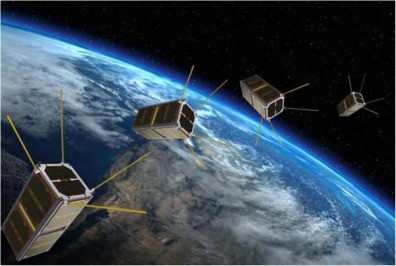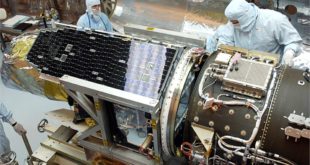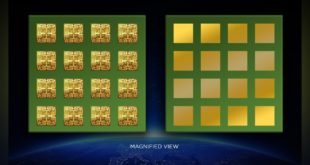Satellites play a crucial role to improve lives in today’s digital economy. Nearly every industry relies upon satellite technology in some way — from agriculture to banking to transportation. Satellites help save lives in emergencies and provide critical knowledge about how to better protect the environment.
Satellite communication refers to any communication link that involves the use of an artificial satellite in its propagation path. Satellite communications play a vital role in modern life. There are over 2000 artificial satellites in use. They can be found in geostationary, Molniya, elliptical, and low Earth orbits and are used for traditional point-to-point communications, mobile applications, and the distribution of TV and radio programs.
Transmissions via satellite communications systems can bypass the existing ground-based infrastructure, which is often limited and unreliable in many parts of the world. They are ideally suited to meet the global communications requirements of military, government and commercial organizations because they provide economical, scalable and highly reliable transmission services that easily reach multiple sites over vast geographic areas.
Market
The global satellite communication (SATCOM) market size was valued at USD 27.56 billion in 2021. It is projected to grow from USD 29.98 billion in 2022 to USD 56.74 billion by 2029 at a CAGR of 9.54% during the forecast period.
The use of Satellite Communication is extensively in television, telephone, radio, internet, and military applications. A large range of radio and microwave frequencies are used for Satellite Communication. The purpose of communications satellites is to relay the signal across the curve of the Earth allowing communication among broadly separated geographical points. It covers a wide area of the earth subsequently whole country or location may be covered with simply one satellite.
Driver
- Satellite communication market will find lucrative growth opportunities in the agriculture and public safety industry in the coming years. The rise in demand is due to the need to transfer data collected by observational and navigational satellites, thus bolstering growth of data communication.
- Companies are increasingly using SATCOM to collect operational data to improve efficiency and realize more sustainable business practices. Companies with operations in geographically remote areas rely heavily on satellite communication to enable real-time asset monitoring and facility monitoring at offshore platforms and unmanned sites. Furthermore, because many business facilities are located in remote areas, deploying terrestrial networks cloud becomes an expensive endeavor. As a result, these companies opt for satellite/mobile satellite services. These factors are going to accelerate the demand for SATCOM in the market over the forecast year.
- According to Skyquest analysis, some of the primary factors driving the Satellite Communication (SATCOM) Market growth are emerging applications and business models, as well as falling device costs, which have aided in driving IoT adoption, increasing the number of connected devices and endpoints globally. The massive IoT technologies NB-IoT and Cat-M1 are still being deployed globally. Massive IoT technologies are expected to account for 51% of all cellular IoT connections, surpassing broadband IoT cellular connections. This massive increase in IoT adoption is driving the demand for satellite communication, thereby supporting the growth of the Satellite Communication (SATCOM) Market under consideration.
Restraint
- The high development and maintenance costs in SATCOM are expected to be a restraint for the global Satellite Communication (SATCOM) Market over the forecast period. The use of satellite communication in transportation networks, including logistics, is expected to increase in the coming years, providing new and diverse growth opportunities for the global market.
Global Satellite Communication (SATCOM) Market Segmental Analysis
The Global Satellite Communication (SATCOM) Market is segmented based on Components, Applications, Verticals, and regions. Based on Components it is categorized into Equipment (SATCOM Transmitter/Transponder, SATCOM Antenna, SATCOM Transceiver, SATCOM Receiver, SATCOM Modem/Router, Others), and Services.
Based on Application it is categorized into Asset Tracking/Monitoring, Airtime (M2M, Voice, Data), Drones Connectivity, Data Backup and Recovery, Navigation and Monitoring, Tele-medicine, Broadcasting, and Others.
Based on Verticals it is categorized into Energy & Utility, Government & Defense (Government, Emergency Responders, Defense), Transport & Cargo (Fleet Management, Rail services), Maritime, Mining, and Oil & Gas (Oil & Gas, Mining), Agriculture, Communication Companies, Corporates/Enterprises, Media & Broadcasting, Events, Aviation, Environmental & Monitoring, Forestry, End User – Consumer, Healthcare, Others. Based on the region it is categorized into North America, Europe, Asia-Pacific, South America, and MEA.
In 2021, the SATCOM equipment segment accounted for more than 40% of the market. The segment is likely to maintain its dominance and grow at the fastest rate throughout the forecast period. The segment is subdivided further into SATCOM transmitter/transponder, antenna, transceiver, receiver, modem/router, and others. The growing need for continuous communication in a variety of industries, including oil and gas, energy and utilities, agriculture, and defense, as well as the global fleet of connected and autonomous vehicles, are driving growth in the equipment segment.
SATCOM equipment is widely used in a wide range of applications, including military surveillance, weather monitoring, navigation, and telecommunications. Furthermore, during wartime, SATCOM equipment is used to collect real-time data, locate undetected tunnels, integrate targets, and track movements, among other things. Furthermore, the growing demand for high-throughput satellite services, as well as the increasing adoption of cloud-based services for ground mobility platforms, are driving the segment’s growth.
Analysis by Application
Surging Demand for DTH Services and Internet from End-users Will Favor Broadcasting Segment
In terms of application, the market is classified into remote sensing, military applications and navigations, weather monitoring, broadcasting, and others. The broadcasting segment is expected to rule the market due to the surging demand for DTH services and internet from end-users.
In 2021, the broadcasting segment dominated the SATCOM market, accounting for approximately 22% of the Satellite Communication (SATCOM) Market share. Over the forecast period, the segment is expected to maintain its lead. Broadcasting services include direct-to-consumer television and radio, as well as mobile broadcasting services. The advantages of satellite TV, a type of pay-TV, and radio, such as seamless connectivity in remote areas or locations, are fueling the segment’s growth. However, the prevalence of over-the-top (OTT) services has been observed to stifle Satellite Communication (SATCOM) Market growth. Airtime, navigation and monitoring, asset tracking, data backup and recovery, drone connectivity, telemedicine, and other services are included in the application segment.
Rising Use of Satellite Communication in the Telecommunication Industry Spurs Product Demand
With regards to end-user, the market is bifurcated into commercial and government & defense. The commercial segment is expected to show higher growth due to the rising use of satellite communication in the telecommunication industry.
Rising Adoption of Better Devices Drives the Transceiver Segment
Based on components, the market is categorized into transmitter/transponder, transceiver, antenna, receiver, and others. The transceiver segment will dominate due to the rising replacement of receivers and transmitters with better transceiver systems.
Growing applications and adoption of Artificial Intelligence (AI) and the Internet of Things (IoT) have paved the way for Intelligent Transport Systems (ITS). These systems permit customers to track cars or motors and permit freight operators to share and receive information promptly. Using satellite communication for transportation will permit seamless and non-stop transmission of data among the vehicle and the transport hub, filling the gaps of the terrestrial networks. Therefore, the usage of satellites for communication in transport networks, which includes logistics, will provide adequate growth opportunities for the market.
Global Satellite Communication (SATCOM) Market Regional Insights
North America dominated the satellite communication market, accounting for more than 35% in 2021. The increase is attributed to the defense industry’s increasing demand for continuous communication and the US defense department’s increased demand for SATCOM equipment. Furthermore, the presence of a large number of SATCOM providers, such as Viasat, Inc., Telesat, and EchoStar Corporation, is fueling the Satellite Communication (SATCOM) Market growth. Furthermore, the North American market is expected to expand at a significant CAGR in the coming years as military communication infrastructure is strengthened.
The Asia Pacific region is expected to grow the most during the forecast period. China and Japan are major contributors to the expansion of this regional market. The increased use of satellite antennas in the telecommunications, information technology, aerospace, and automobile industries can be attributed to the growth. Europe is expected to experience the second-fastest growth in the coming years as a result of infrastructure modernization and increased passenger traffic in marine and coastal tourism.
The major players in the market are Boeing (US), Cobham Limited (UK), General Dynamics Corporation (US), Indra (Spain), Gilat Satellite Networks, Inmarsat Global Limited (UK), L3Harris Technologies, Inc. (US), Qualcomm Technologies, Inc. (US), Viasat, Inc. (US), Gilat Satellite Networks (Israel), SKY Perfect JSAT Group, L3 Technologies, Inc., SES S.A, Telesat, Intelsat, and Thuraya Telecommunications Company.
Key Developments in Satellite Communication Market
- In March 2021, SKY Perfect JSAT signs contract with Airbus to build Superbird-9 telecommunications satellite.
- In August 2020, Intelsat successfully launched of Galaxy 30, a satellite that will provide Intelsat Media customers in North America with high-performance broadcast distribution capabilities.
- In June 2022, ISRO will be launching the communication satellite GSAT-24 from French Guiana. GSAT-24 is a 24-Ku band communication satellite that provides pan-India coverage for DTH applications.
- In May 2022, three low-Earth-orbit test communication satellites were launched from China’s Jiuquan Satellite Launch Center in the northwest using a Long March-2C carrier rocket.
References and Resources also include:
https://skyquestt.com/report/satellite-communication-market
 International Defense Security & Technology Your trusted Source for News, Research and Analysis
International Defense Security & Technology Your trusted Source for News, Research and Analysis


